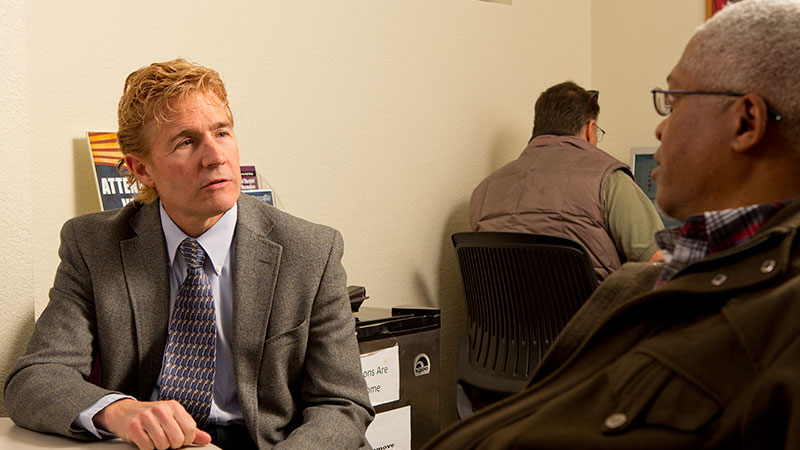In May 2002, John O’Grady graduated from high school in Adams, Minn. That August, he enlisted in the Army, a decision that had nothing to do with the Sept. 2011 terrorist attacks.

Army veteran John O’Grady works with Ann Christensen, a biology instructor at Pima County Community College. After a frustrating start in higher education, O’Grady is optimistic about his choice to enter a program in respiratory care.
“My whole family has done it (military service),” and the Army seemed “a way to grow up and get an education benefit,” recalls O’Grady, 29. As a teenager, he didn’t seriously consider attending college. “I didn’t know how I would afford it. Our guidance counselors weren’t the best.”
Trained to be an ammunitions specialist, O’Grady served for seven years. During his second tour of Iraq, he met, married and divorced an enlisted woman. A combat zone is not the best environment for nurturing a relationship, he learned.
A year after completing his service, O’Grady enrolled in Delaware Technical Community College. Having served in the Iraqi desert, the native Minnesotan found that he could no longer tolerate cold weather. When his best friend in the Army invited him to move in with him and his family in Arizona, O’Grady decided to “take a chance.” He moved to Tucson and enrolled in Pima County Community College.
It didn’t take long for frustration to set in.
“People don’t understand the complexity of what it means to come back home as a veteran. You’ve withdrawn from regular life into a very special environment,” says Ted Roush, vice president of instruction at Pima’s Desert Vista campus. “What they don’t get is what has happened while they were gone. Their lives have moved on without them.”
A first encounter with higher education can intensify the feelings of alienation and disconnectedness that veterans feel upon leaving active-duty service. College “has new rules and new expectations. It’s complete culture shock,” Roush says.

Aside from physical and psychological injuries, “the number one problem for (veterans) is finding someone to answer questions about their benefits. They get frustrated with us,” Roush says. “It’s a real challenge. Our budget has been cut. We don’t have the funds to grow the staff.”
Bewildered about what direction to take, O’Grady opted to pursue certification as a heating, ventilation and air conditioning (HVAC) specialist. He didn’t consider the fact that working with heating and cooling equipment would likely aggravate the back and knees he had injured in an Army training accident.
“When I came to Pima, I was having difficulty adjusting to school,” O’Grady says of the transition, a time when he was drinking more than he was studying. “I was getting frustrated with everything and making really bad choices.”
A couple of years later, O’Grady has eased into college life. He’s working at Pima’s veterans center, which was established a year ago at the college’s downtown campus, and helping other student veterans to succeed. After completing classes in biology and chemistry, O’Grady will soon begin a program in respiratory care. He wants a career that will enable him to afford a house with a yard — and to “live comfortably.”
Pima County Community College is adjusting, as well. The surge of student veterans and their needs has strained institutional resources and infrastructure. The influx won’t abate anytime soon; nor will the challenge of meeting veterans’ needs.
“If you look at the veterans, there is a wide range of ages, experiences, and military backgrounds,” says Jerry Haynes, vice president of student development. “We’re seeing a group of students who may not have been connected with education for a long time.”
In an effort to be more nimble, the system is moving away from “siloed” veterans services and toward a more “holistic approach,” says Leticia Menchaca, assistant vice chancellor for student development. “We have orientation services to introduce college life and to help them navigate the system. We have people to advise them on what classes to take.”
O’Grady has noticed a difference. The help given to veterans at Pima, he says, has improved “dramatically.”
